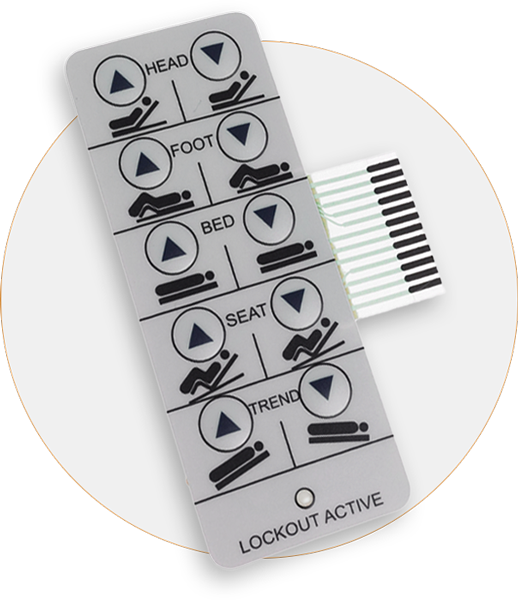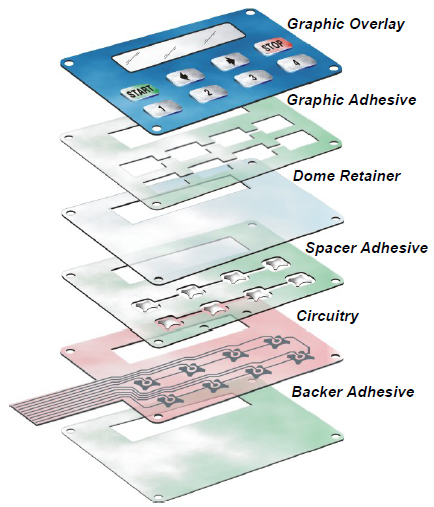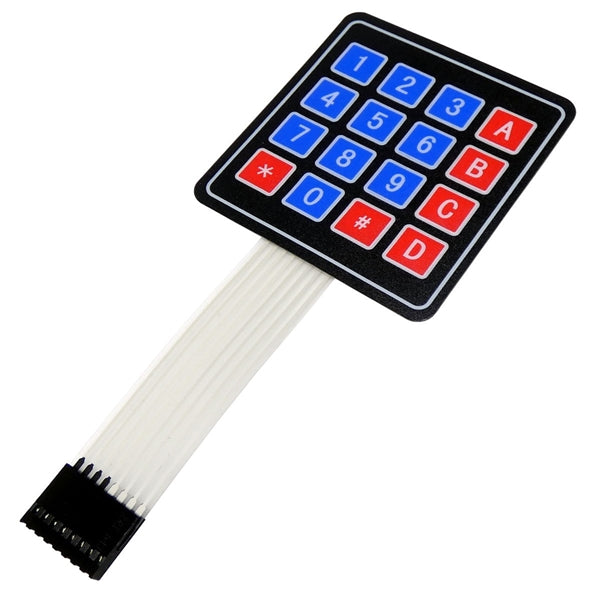Many designers favor working with a proven membrane switch manufacturer for custom builds.
Many designers favor working with a proven membrane switch manufacturer for custom builds.
Blog Article
What to Seek When Selecting a Membrane Switch for Your Job
When you're choosing a membrane button for your project, a number of crucial aspects come right into play. You'll need to believe about the materials, style, and exactly how well it lines up with your brand.
Understanding Membrane Change Components
When you plunge right into the globe of membrane layer switches, it's essential to grasp the vital components that make them function. The button commonly consists of three main layers: the visuals overlay, the spacer layer, and the circuit layer. The visuals overlay supplies the visual user interface, presenting buttons and symbols you need for very easy navigation. Beneath that, the spacer layer guarantees there's enough range between the circuit and the overlay, permitting the button to activate without consistent pressure.
The circuit layer, usually made from printed conductive inks, develops the electrical paths. When you press a button, the circuit shuts, sending a signal to the gadget. Recognizing how these layers function with each other helps you select a membrane layer button that's trustworthy and fits your project demands. Pay very close attention to the density and material of each layer, as these elements affect durability and performance in numerous settings.
Material Choice and Its Influence
Picking the right materials for your membrane switch can greatly impact its performance and longevity. The choice of substrate, generally polyester or polycarbonate, influences sturdiness and versatility. Polyester is a lot more abrasion-resistant, while polycarbonate uses much better clearness and stamina.
Next, take into consideration the adhesive. It needs to withstand ecological variables like dampness and temperature level adjustments. A solid sticky assurances that your membrane switch remains undamaged in time.
Don't ignore the visuals overlay. The printing technique utilized, whether silkscreen or digital, influences the button's appearances and long life. High-grade inks will certainly withstand fading and scratching, keeping a specialist appearance.
Last but not least, consider environmental conditions. If your tool will certainly be subjected to severe chemicals or extreme temperature levels, choose products created to endure these challenges. Your selections in materials will inevitably identify the button's reliability and customer complete satisfaction.
Design Factors To Consider for Individual Experience
Picking the ideal materials lays the structure for a successful membrane layer switch, yet the layout also plays a significant role in customer experience. You'll wish to assess exactly how the layout influences usability (membrane switch manufacturer). Keep switches and icons instinctive and well-spaced, making it easy for individuals to browse without confusion

Color and comparison are additionally vital; warranty that your design is visually enticing however still practical. High comparison helps individuals quickly identify buttons, specifically in low-light problems.
Lastly, assess the general visual. A streamlined and modern-day layout can elevate individual understanding and make your product extra enticing. Stabilizing performance with an interesting design will result in a far better customer experience and inevitably, a much more successful product.

Environmental Elements and Longevity
When picking a membrane layer button, you require to take into consideration just how it'll do in different atmospheres. Factors like temperature resistance, moisture and chemical exposure, and mechanical wear can greatly impact its sturdiness. Comprehending these aspects will help you choose a button that takes on your certain conditions.
Temperature Level Resistance Needs
As environmental problems can vary commonly, recognizing temperature resistance is crucial for making sure the toughness of your membrane layer button. Make sure to inspect the specs of the materials utilized in the switch, like the sticky and overlay, as they straight influence performance. By choosing a membrane layer button with appropriate temperature resistance, you'll boost its life expectancy and keep capability in challenging atmospheres.

Moisture and Chemical Exposure
Wetness and chemical direct exposure can greatly affect the performance and longevity of your membrane button, so it's important to recognize the setting in which it will certainly be made use of. If your task includes high moisture or direct exposure to fluids, seek safety coatings and sealers that can improve resistance to moisture. Additionally, think about the kinds of chemicals your switch may run into. Particular products can deteriorate when subjected to solvents, oils, or severe cleaners. Choosing the right materials, like polycarbonate or polyester, can help stand up to these components. Constantly speak with the producer's specifications for chemical compatibility to assure your membrane layer switch keeps its functionality with time. By focusing on wetness and chemical resistance, you can improve the toughness of your button in difficult environments.
Mechanical Use and Tear
While you may focus on attributes like appearances and performance in your membrane switch, mechanical damage can significantly affect its efficiency gradually. Take into consideration how frequently the button will be made use of browse this site and the environment it'll remain in. Frequent pressing can result in destruction of materials, creating issues like tactile comments loss or also switch failure. Seek models with durable styles, such as those with safety overlays that resist scratches and put on. Additionally, look for specifications on cycle life, which suggests the amount of presses the button can handle before showing indicators of wear. Choosing a sturdy button guarantees durability and integrity, stopping expensive substitutes and downtime in your job. Constantly element in longevity alongside looks and capability for peak performance.
Customization Options for Branding
When it concerns branding your membrane switch, modification options are essential. You can pick layout components and colors that show your brand name, in addition to certain logo design placement and size to enhance presence. In addition, picking the ideal products and structures can raise the general look and feel, making your product attract attention.
Layout Elements and Colors
A variety of design aspects and colors can make your membrane layer button not just useful but also aesthetically enticing, improving your brand identification. When selecting colors, consider your brand's combination; they must resonate with your target market and stimulate the appropriate emotions. You can also discover numerous surfaces like matte or glossy to develop different aesthetic impacts. Don't forget textures; including a tactile component can improve user experience and make your button stick out. Consider including customized graphics or patterns that straighten with your brand message. By attentively selecting style elements and colors, you not just create an item that looks terrific yet also enhances your branding consistently and successfully.
Logo Design Placement and Size
After finalizing your style aspects and shades, the following action is to concentrate on logo design positioning and dimension. Your logo design is an essential aspect of your branding, so you'll want it to stand apart without frustrating various other style components. Review where your logo design will certainly be most noticeable and impactful; usual positionings consist of the leading or facility of the button.
Assume about the size as well-- too big and it may eclipse practical aspects, as well tiny and it can obtain shed. Go for a balance that allows your logo to be quickly recognizable while keeping the overall visual appeals. Do not fail to remember to consider how the logo aligns with user communication. This focus to information will certainly boost both capability and brand identification in your task.
Product and Appearance Options
Selecting the best products and appearances for your membrane layer button can greatly enhance both its performance and aesthetic charm. You'll desire to review alternatives like polyester or polycarbonate, as they supply longevity and resistance to put on. The structure of the surface area likewise plays a necessary duty; smooth coatings give a streamlined appearance, while textured surfaces can boost hold and tactile responses.
Personalizing the products and appearances permits you to reflect your brand identification successfully. For example, you might pick a matte finish to share elegance or a shiny seek a modern-day touch - membrane switch manufacturer. Don't forget regarding shade options, as lively hues can make your button stand apart, while low-key tones can create a much more elegant appearance
Price vs. Quality: Discovering the Right Equilibrium
When you're handling the options for membrane buttons, balancing expense and top quality can really feel overwhelming. You wish to ensure that you're getting a trustworthy item without breaking the look at more info bank. Beginning by recognizing your job's details needs. Are you prioritizing durability or appearances? A lower-cost switch may save you money upfront, however if it endangers capability, you can encounter greater replacement costs later.
Try to find suppliers that use a good mix of cost and high criteria. Research study their credibility and client testimonials to determine dependability. In some cases, investing a little bit extra in quality products can conserve you from future migraines.
Likewise, consider the lasting efficiency and guarantee choices. A slightly more pricey button with a solid warranty can confirm to be a smarter financial investment. Ultimately, it has to do with locating that wonderful area where you satisfy your budget plan while ensuring your task's success.
Checking and Quality Control Protocols
While you might discover the perfect membrane layer switch design, ensuring its top quality with rigorous screening protocols is essential for lasting success. Start by validating that the producer complies with market standards, such as IPC/WHMA-A -620, to assure a reliable item. membrane switch manufacturer. You'll wish to look for extensive screening techniques, consisting of environmental, mechanical, and electric assessments
Ensure the buttons go through longevity testing, replicating real-world use to recognize any type of potential see it here failings. Take note of the producer's quality control process, which need to consist of normal assessments and audits.

Do not forget to ask for examples and perform your very own examinations to validate compatibility with your project. Lastly, think about how frequently the maker updates their methods; technology in screening can lead to improved quality. By focusing on these screening and quality control protocols, you'll increase the likelihood of a successful and resilient membrane button for your application.
Regularly Asked Inquiries
Exactly how Long Does a Membrane Switch Typically Last?
A membrane switch generally lasts anywhere from 1 to 10 million cycles, depending upon use and environmental elements. You'll want to think about your details requirements to assure it fulfills your long life needs properly.
Can Membrane Layer Switches Over Be Fixed if Damaged?
Yes, you can often fix membrane layer buttons if they're harmed, but it usually depends on the level of the damage. Small problems could be fixable, while extra considerable damage generally needs replacement for correct performance.
What Are the Usual Applications for Membrane Layer Switches?
Membrane layer switches are generally utilized in devices, medical tools, and vehicle controls. You'll find them in customer electronics, commercial equipment, and even pc gaming consoles. Their convenience makes them optimal for numerous interface and environments.
Are There Details Accreditations for Membrane Layer Switches?
Yes, there specify qualifications for membrane buttons. Search for UL, CE, and RoHS qualifications to guarantee safety and security and compliance. These accreditations suggest the button meets market criteria for quality and environmental safety and security.
How Do I Make Sure Correct Installation of a Membrane Change?
To assure proper setup of a membrane layer button, clean the surface completely, align it meticulously, and apply even pressure. Comply with supplier standards for adhesive curing time to maximize toughness and capability.
Conclusion
When selecting a membrane switch for your project, maintain these crucial aspects in mind: prioritize durable products, focus on user-friendly layout, and think about personalization for your brand. By meticulously reviewing these elements, you'll guarantee your membrane layer button not only meets your task needs however likewise improves individual experience and shows your brand name identification efficiently.
Report this page